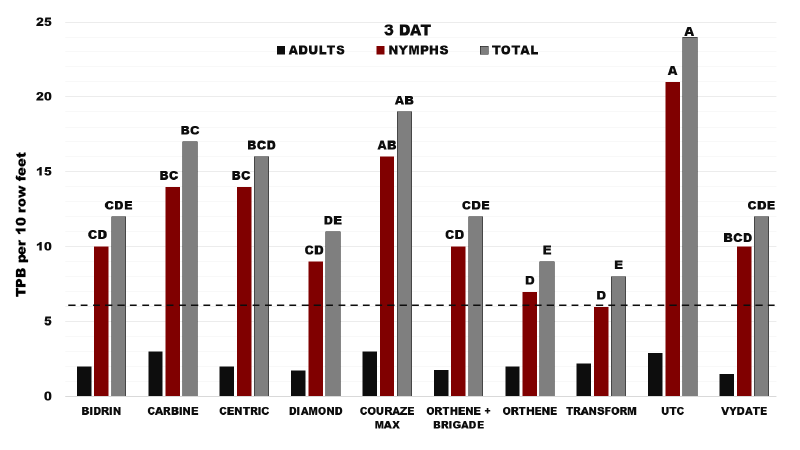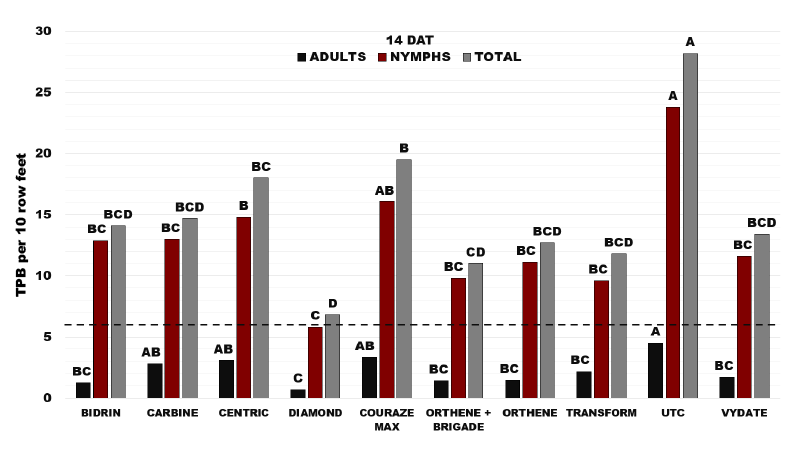Insecticide Performance on Tarnished Plant Bugs in Mississippi Cotton
The most economically important insect pest—not only in Mississippi cotton but across the Midsouth region of the U.S.—is the tarnished plant bug (TPB), Lygus lineolaris. On average, four to seven insecticide applications are needed annually in the Mississippi Delta region to control TPB.
Over the last several years, entomologists have conducted standardized efficacy studies to evaluate the most commonly used TPB insecticides. The objective of these studies is to evaluate the performance of commonly used insecticides as stand-alone products. The data from these studies suggest that the majority of available insecticides do not provide adequate control as a single application or when not in combination with another insecticide.
Methods
In 2018, 2019, and 2020, field studies sponsored by Cotton Incorporated were conducted in Glendora and Stoneville, Mississippi. Plots were four 40-foot-long rows planted on 38- or 40-inch row spacings. All treatments were replicated four times. Treatments were sprayed at 10 gallons per acre using hollow cone nozzles at 65 pounds per square inch with a high-clearance sprayer. Treatments were evaluated for both adult and nymph TPB 3, 7, 10, and 14 days after treatment. At each sample date, two drop cloth samples were taken per plot with a standard 5-foot black drop cloth for a total of 10 row feet sampled.
Treatments
|
Treatment |
Rate (oz/acre) |
|---|---|
|
Bidrin |
6 |
|
Carbine |
2.85 |
|
Centric |
2 |
|
Diamond |
9 |
|
Couraze Max (imidacloprid) |
2 |
|
Orthene plus Brigade |
12 + 6.4 |
|
Orthene |
12 |
|
Transform |
1.5 |
|
Untreated control (UTC) |
– |
|
Vydate |
12.8 |
Results
At 3 days after treatment (DAT), none of the insecticides reduced plant bug populations below the economic threshold (6/10 row feet). At 7 DAT, only Transform and Diamond reduced nymph populations below the threshold. At 10 DAT, Orthene + Brigade, Orthene, and Transform were the only treatments that reduced nymph populations below the economic threshold. At 14 DAT, only Diamond provided acceptable control. See Figures 1–4. Although adult TPB were recorded in these studies, it is difficult to prevent plot-to-plot movement in these settings, and nymphal numbers are more reliable indicators of insecticide performance.
Single applications of these insecticides did not provide above 80 percent control at any of the rating intervals. In many areas of Mississippi, insecticide resistance to several modes of action has been well documented. These data suggest that, in areas where TPB populations are increasing, it will be difficult to achieve acceptable control with a single application of any of the most commonly used insecticides available. Shortening treatment intervals to less than 7 days and alternating modes of action is necessary to provide adequate control where populations are high.




The information given here is for educational purposes only. References to commercial products, trade names, or suppliers are made with the understanding that no endorsement is implied and that no discrimination against other products or suppliers is intended.
Publication 3548 (POD-10-20)
By Whitney Crow, PhD, Assistant Professor, Delta Research and Extension Center; Angus Catchot, PhD, Extension Professor, Entomology; Jeff Gore, PhD, Research Professor, Delta Research and Extension Center; and Don Cook, PhD, Associate Research Professor, Delta Research and Extension Center.
The Mississippi State University Extension Service is working to ensure all web content is accessible to all users. If you need assistance accessing any of our content, please email the webteam or call 662-325-2262.








